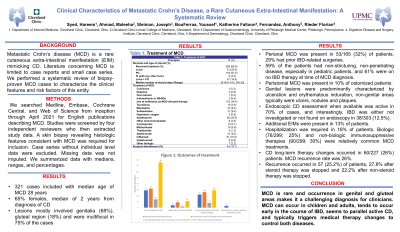Monday Poster Session
Category: IBD
P2195 - Clinical Characteristics of Metastatic Crohn’s Disease, a Rare Cutaneous Extra-Intestinal Manifestation: A Systematic Review
Monday, October 23, 2023
10:30 AM - 4:15 PM PT
Location: Exhibit Hall


Hareem Syed, MD
Cleveland Clinic
Cleveland, OH
Presenting Author(s)
Hareem Syed, MD1, Maleeha Ahmad, BS2, Joseph Sleiman, MD3, Youssef Bouferraa, MD1, Katherine Falloon, MD1, Anthony P. Fernandez, MD, PhD1, Florian Rieder, MD1
1Cleveland Clinic, Cleveland, OH; 2Cleveland Clinic Lerner College of Medicine, Cleveland, OH; 3University of Pittsburgh Medical Center, Pittsburgh, PA
Introduction: Metastatic Crohn’s disease (MCD) is a rare cutaneous extra-intestinal manifestation (EIM) mimicking crohn's disease (CD). Literature concerning MCD is limited to case reports and small case series. We performed a systematic review of biopsy proven MCD cases to characterize the clinical features and risk factors of this entity.
Methods: We searched Medline, Embase, Cochrane Central, and Web of Science from inception through April 2021 for English publications describing MCD. Studies were screened by four independent reviewers who then extracted study data. A skin biopsy revealing histologic features consistent with MCD was required for inclusion. Case series without individual level data were excluded. Missing data was not imputed. We summarized data with medians, ranges, and percentages.
Results: In 321 included cases, MCD occurred at median of 28 years, mostly in females (65%) and within a median of 2 years (range -11; 43) from CD diagnosis. About 27% of cases occurred within 3 months of CD diagnosis. MCD lesions mostly involved genital (68%) and gluteal (18%) areas, but were multifocal in 75% of cases. Perianal MCD was present in 53/165 (32%) of patients, 29% had prior IBD-related surgeries. Most patients (59%) had non-stricturing, non-penetrating disease, especially in pediatric patients, and 61% were on no IBD therapy at time of MCD diagnosis. Peristomal MCD was present in 10% of ostomized patients. Genital lesions were predominantly characterized by ulceration and erythematous induration, non-genital areas typically were ulcers, nodules and plaques. Endoscopic CD assessment when available was active in 70% of cases, and interestingly, IBD was either not investigated or not found on endoscopy in 38/303 (12.5%). Additional EIMs were present in 13% of patients.
Treatment characteristics for MCD are summarized in Table 1. Hospitalization was required in 18% of patients. Biologic (76/299; 25%) and non-biologic immunosuppressive therapies (90/299; 30%) were relatively common MCD treatments. CD long-term therapy changes occurred in 60/227 (26%) patients. MCD recurrence rate was 26%.
Discussion: MCD is rare and occurrence in genital and gluteal areas makes it a challenging diagnosis for clinicians. MCD can occur in children and adults, tends to occur early in the course of IBD, seems to parallel active CD, and typically triggers medical therapy changes to control both diseases.
Disclosures:
Hareem Syed, MD1, Maleeha Ahmad, BS2, Joseph Sleiman, MD3, Youssef Bouferraa, MD1, Katherine Falloon, MD1, Anthony P. Fernandez, MD, PhD1, Florian Rieder, MD1. P2195 - Clinical Characteristics of Metastatic Crohn’s Disease, a Rare Cutaneous Extra-Intestinal Manifestation: A Systematic Review, ACG 2023 Annual Scientific Meeting Abstracts. Vancouver, BC, Canada: American College of Gastroenterology.
1Cleveland Clinic, Cleveland, OH; 2Cleveland Clinic Lerner College of Medicine, Cleveland, OH; 3University of Pittsburgh Medical Center, Pittsburgh, PA
Introduction: Metastatic Crohn’s disease (MCD) is a rare cutaneous extra-intestinal manifestation (EIM) mimicking crohn's disease (CD). Literature concerning MCD is limited to case reports and small case series. We performed a systematic review of biopsy proven MCD cases to characterize the clinical features and risk factors of this entity.
Methods: We searched Medline, Embase, Cochrane Central, and Web of Science from inception through April 2021 for English publications describing MCD. Studies were screened by four independent reviewers who then extracted study data. A skin biopsy revealing histologic features consistent with MCD was required for inclusion. Case series without individual level data were excluded. Missing data was not imputed. We summarized data with medians, ranges, and percentages.
Results: In 321 included cases, MCD occurred at median of 28 years, mostly in females (65%) and within a median of 2 years (range -11; 43) from CD diagnosis. About 27% of cases occurred within 3 months of CD diagnosis. MCD lesions mostly involved genital (68%) and gluteal (18%) areas, but were multifocal in 75% of cases. Perianal MCD was present in 53/165 (32%) of patients, 29% had prior IBD-related surgeries. Most patients (59%) had non-stricturing, non-penetrating disease, especially in pediatric patients, and 61% were on no IBD therapy at time of MCD diagnosis. Peristomal MCD was present in 10% of ostomized patients. Genital lesions were predominantly characterized by ulceration and erythematous induration, non-genital areas typically were ulcers, nodules and plaques. Endoscopic CD assessment when available was active in 70% of cases, and interestingly, IBD was either not investigated or not found on endoscopy in 38/303 (12.5%). Additional EIMs were present in 13% of patients.
Treatment characteristics for MCD are summarized in Table 1. Hospitalization was required in 18% of patients. Biologic (76/299; 25%) and non-biologic immunosuppressive therapies (90/299; 30%) were relatively common MCD treatments. CD long-term therapy changes occurred in 60/227 (26%) patients. MCD recurrence rate was 26%.
Discussion: MCD is rare and occurrence in genital and gluteal areas makes it a challenging diagnosis for clinicians. MCD can occur in children and adults, tends to occur early in the course of IBD, seems to parallel active CD, and typically triggers medical therapy changes to control both diseases.
Disclosures:
Hareem Syed indicated no relevant financial relationships.
Maleeha Ahmad indicated no relevant financial relationships.
Joseph Sleiman indicated no relevant financial relationships.
Youssef Bouferraa indicated no relevant financial relationships.
Katherine Falloon: Janssen – GI Fellows Steering Committee.
Anthony Fernandez: AbbVie/Abbott – Advisory Committee/Board Member, Consultant, Speakers Bureau. Alexion – Grant/Research Support. BMS – Advisory Committee/Board Member. Kyowa Kirin – Speakers Bureau. mallinckrodt – Consultant, Grant/Research Support, Speakers Bureau. Novartis – Consultant, Grant/Research Support. Pfizer – Grant/Research Support.
Florian Rieder: 89Bio – Advisory Committee/Board Member, Consultant. Abbvie – Advisory Committee/Board Member, Consultant. Adnovate – Advisory Committee/Board Member, Consultant. Agomab – Advisory Committee/Board Member, Consultant. Allergan – Advisory Committee/Board Member, Consultant. Arena – Advisory Committee/Board Member, Consultant. Boehringer Ingelheim – Advisory Committee/Board Member, Consultant. CDISC – Advisory Committee/Board Member, Consultant. Celgene/Bristol Myers Squibb – Advisory Committee/Board Member, Consultant. Ferring – Advisory Committee/Board Member, Consultant. Galapagos – Advisory Committee/Board Member, Consultant. Galmed Pharmaceuticals – Advisory Committee/Board Member, Consultant. Genentech – Advisory Committee/Board Member, Consultant. Gilead – Advisory Committee/Board Member, Consultant. Gossamer – Advisory Committee/Board Member, Consultant. Guidepoint – Advisory Committee/Board Member, Consultant. Helmsley – Advisory Committee/Board Member, Consultant. Horizon Therapeutics – Advisory Committee/Board Member, Consultant. Image Analysis Limited – Advisory Committee/Board Member, Consultant. Index Pharmaceuticals – Advisory Committee/Board Member, Consultant. Janssen – Advisory Committee/Board Member, Consultant. Koutif Therapeutics – Advisory Committee/Board Member, Consultant. Mestag Therapeutics – Advisory Committee/Board Member, Consultant. Metacrine – Advisory Committee/Board Member, Consultant. Morphic Therapeutic – Advisory Committee/Board Member, Consultant. Organovo – Advisory Committee/Board Member, Consultant. Origo – Advisory Committee/Board Member, Consultant. Pfizer – Advisory Committee/Board Member, Consultant. Pliant – Advisory Committee/Board Member, Consultant. Prometheus Biosciences – Advisory Committee/Board Member, Consultant. Receptos – Advisory Committee/Board Member, Consultant. REDX – Advisory Committee/Board Member, Consultant. Roche – Advisory Committee/Board Member, Consultant. Samsung – Advisory Committee/Board Member, Consultant. Surmodics – Advisory Committee/Board Member, Consultant. Surrozen – Advisory Committee/Board Member, Consultant. Takeda – Advisory Committee/Board Member, Consultant. TD Cowen – Advisory Committee/Board Member, Consultant. Techlab – Advisory Committee/Board Member, Consultant. Theravance – Advisory Committee/Board Member, Consultant. Thetis Pharmaceuticals – Advisory Committee/Board Member, Consultant. UCB – Advisory Committee/Board Member, Consultant. Ysios Capital – Advisory Committee/Board Member, Consultant.
Hareem Syed, MD1, Maleeha Ahmad, BS2, Joseph Sleiman, MD3, Youssef Bouferraa, MD1, Katherine Falloon, MD1, Anthony P. Fernandez, MD, PhD1, Florian Rieder, MD1. P2195 - Clinical Characteristics of Metastatic Crohn’s Disease, a Rare Cutaneous Extra-Intestinal Manifestation: A Systematic Review, ACG 2023 Annual Scientific Meeting Abstracts. Vancouver, BC, Canada: American College of Gastroenterology.
